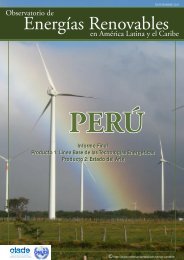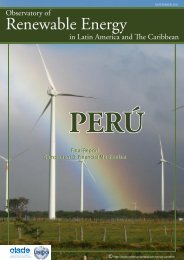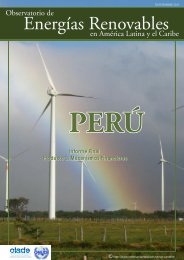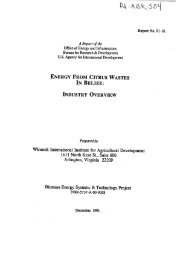PERÃ - Observatory for Renewable Energy in Latin America and
PERÃ - Observatory for Renewable Energy in Latin America and
PERÃ - Observatory for Renewable Energy in Latin America and
Create successful ePaper yourself
Turn your PDF publications into a flip-book with our unique Google optimized e-Paper software.
<br />
Perú- Products I <strong>and</strong> II<br />
<br />
1.3.4 <strong>Energy</strong> Potential<br />
Peru has renewable <strong>and</strong> non renewable energy reserves. Of the last ones, it st<strong>and</strong>s<br />
out the natural gas <strong>and</strong> its liquids, but there are also reserves of oil <strong>and</strong> coal. The<br />
entrance to the energy matrix of the natural gas from Camisea took place on<br />
August 2004. This energy source is currently used <strong>in</strong> electricity generation <strong>and</strong> as<br />
fuel <strong>in</strong> transportation, <strong>in</strong>dustrial <strong>and</strong> residential sectors (MEM, 2009a).<br />
Camisea is the biggest deposit of natural gas under exploitation <strong>in</strong> Peru. It is<br />
located <strong>in</strong> the Lower Urubamba, Echarate District, The Convención Prov<strong>in</strong>ce <strong>in</strong><br />
Cusco Region. See Graphic Nº 4.<br />
Graphic N° 4: Location of the Camisea Deposit <strong>and</strong> Transport System of Natural Gas <strong>and</strong><br />
Liquids<br />
In-situ proven reserves are 8.7 TCF (trillion cubic feet), <strong>and</strong> the probable proven<br />
ones are estimated <strong>in</strong> 11 TCF. The expected f<strong>in</strong>al recovery is of 8.24 TCF of<br />
natural gas <strong>and</strong> 482 million barrels of natural gas liquids. (PLUSPETROL, 2011).<br />
As <strong>for</strong> the renewable energy potential, accord<strong>in</strong>g to the <strong>in</strong><strong>for</strong>mation spread out by<br />
the MEM, the country has an important hydroelectric potential estimated <strong>in</strong> 70<br />
000 MW, of which it has been us<strong>in</strong>g only 5 %; (MEM, 2011a). On the other h<strong>and</strong>,<br />
the w<strong>in</strong>d power potential is estimated <strong>in</strong> 20 000 MW <strong>and</strong> the solar energy<br />
potential, accord<strong>in</strong>g to the Peruvian Solar <strong>Energy</strong> Atlas, has levels between 6,0 to<br />
6,5 kWh/m 2 of yearly solar radiation <strong>in</strong> the coast, of 5,5 to 6,0 kWh/m 2 <strong>in</strong> the<br />
highl<strong>and</strong>s <strong>and</strong> of 4,5 to 5,0 kWh/m 2 <strong>in</strong> the jungle (MEM, 2011d). However, the<br />
use of w<strong>in</strong>d <strong>and</strong> solar energy started up recently with the <strong>in</strong>stallation of four solar<br />
energy projects with a total <strong>in</strong>stalled capacity of 80 MW <strong>and</strong> three w<strong>in</strong>d farms<br />
with a total <strong>in</strong>stalled capacity of 140 MW. In addition, it is estimated a total<br />
supply of 272 yearly million metric tons of biomass resources <strong>for</strong> electricity<br />
generation, of which 256 million correspond to the average <strong>for</strong>ests’s productivity<br />
(natives <strong>and</strong> plantations) <strong>and</strong> 16 million to come from other sources like the<br />
wastes of maize, rice, sugar cane, cotton, asparaguses <strong>and</strong> olive fields (FAO,<br />
17









